
| Original Article Online Publishing Date: | ||||||||||||
Effectiveness of the selection of administered 131I-iodide activity based on the thyroid "volume algorithm" approach for the therapy of Graves' disease Federica Guidoccio, Antonio Claudio Traino, Federica Orsini, Duccio Volterrani, Giuliano Mariani, Mariano Grosso.
| ||||||||||||
| How to Cite this Article |
| Pubmed Style Guidoccio F, Traino AC, Orsini F, Volterrani D, Mariani G, Grosso M. Effectiveness of the selection of administered 131I-iodide activity based on the thyroid "volume algorithm" approach for the therapy of Graves' disease. Pak J Nucl Med. 2020; 10(1): 4-12. doi:10.24911/PJNMed.175-1577458976 Web Style Guidoccio F, Traino AC, Orsini F, Volterrani D, Mariani G, Grosso M. Effectiveness of the selection of administered 131I-iodide activity based on the thyroid "volume algorithm" approach for the therapy of Graves' disease. https://www.pjnmed.com/?mno=79616 [Access: February 27, 2024]. doi:10.24911/PJNMed.175-1577458976 AMA (American Medical Association) Style Guidoccio F, Traino AC, Orsini F, Volterrani D, Mariani G, Grosso M. Effectiveness of the selection of administered 131I-iodide activity based on the thyroid "volume algorithm" approach for the therapy of Graves' disease. Pak J Nucl Med. 2020; 10(1): 4-12. doi:10.24911/PJNMed.175-1577458976 Vancouver/ICMJE Style Guidoccio F, Traino AC, Orsini F, Volterrani D, Mariani G, Grosso M. Effectiveness of the selection of administered 131I-iodide activity based on the thyroid "volume algorithm" approach for the therapy of Graves' disease. Pak J Nucl Med. (2020), [cited February 27, 2024]; 10(1): 4-12. doi:10.24911/PJNMed.175-1577458976 Harvard Style Guidoccio, F., Traino, . A. C., Orsini, . F., Volterrani, . D., Mariani, . G. & Grosso, . M. (2020) Effectiveness of the selection of administered 131I-iodide activity based on the thyroid "volume algorithm" approach for the therapy of Graves' disease. Pak J Nucl Med, 10 (1), 4-12. doi:10.24911/PJNMed.175-1577458976 Turabian Style Guidoccio, Federica, Antonio Claudio Traino, Federica Orsini, Duccio Volterrani, Giuliano Mariani, and Mariano Grosso. 2020. Effectiveness of the selection of administered 131I-iodide activity based on the thyroid "volume algorithm" approach for the therapy of Graves' disease. Pakistan Journal of Nuclear Medicine, 10 (1), 4-12. doi:10.24911/PJNMed.175-1577458976 Chicago Style Guidoccio, Federica, Antonio Claudio Traino, Federica Orsini, Duccio Volterrani, Giuliano Mariani, and Mariano Grosso. "Effectiveness of the selection of administered 131I-iodide activity based on the thyroid "volume algorithm" approach for the therapy of Graves' disease." Pakistan Journal of Nuclear Medicine 10 (2020), 4-12. doi:10.24911/PJNMed.175-1577458976 MLA (The Modern Language Association) Style Guidoccio, Federica, Antonio Claudio Traino, Federica Orsini, Duccio Volterrani, Giuliano Mariani, and Mariano Grosso. "Effectiveness of the selection of administered 131I-iodide activity based on the thyroid "volume algorithm" approach for the therapy of Graves' disease." Pakistan Journal of Nuclear Medicine 10.1 (2020), 4-12. Print. doi:10.24911/PJNMed.175-1577458976 APA (American Psychological Association) Style Guidoccio, F., Traino, . A. C., Orsini, . F., Volterrani, . D., Mariani, . G. & Grosso, . M. (2020) Effectiveness of the selection of administered 131I-iodide activity based on the thyroid "volume algorithm" approach for the therapy of Graves' disease. Pakistan Journal of Nuclear Medicine, 10 (1), 4-12. doi:10.24911/PJNMed.175-1577458976 |
Xianling Dong, M I Saripan, R Mahmud, S Mashohor, Aihui Wang
Pak J Nucl Med. 2017; 7(1): 9-15
» Abstract » doi: 10.24911/PJNMed.7.2
Sajjad Ahmed Memon, Naeem Ahmed Laghari, Fayaz Hussain Mangi
Pak J Nucl Med. 2017; 7(1): 20-27
» Abstract » doi: 10.24911/PJNMed.7.4
Iqbal Munir, Amrah Javaid, Khalid Nawaz, Mohammed Hathaf Al-Rowaily, Muaadh Abdualrehman Al-Asbahi
Pak J Nucl Med. 2017; 7(1): 28-33
» Abstract » doi: 10.24911/PJNMed.7.5
Sadaf Tufail Butt, Shazia Fatima, Noreen Marwat, Kahkashan Mir, Ayesha Ammar, Mohammad Faheem
Pak J Nucl Med. 2017; 7(1): 34-37
» Abstract » doi: 10.24911/PJNMed.7.6
Mohammed Hathaf Al-Rowaily, Daniele Dondi, MarcoChinol, Iqbal Munir, Muaadh Abdualrehman Alasbahi
Pak J Nucl Med. 2017; 7(1): 4-8
» Abstract » doi: 10.24911/PJNMed.7.1
Sajjad Ahmed Memon, Naeem Ahmed Laghari, Fayaz Hussain Mangi
Pak J Nucl Med. 2017; 7(1): 20-27
» Abstract » doi: 10.24911/PJNMed.7.4
Xianling Dong, M I Saripan, R Mahmud, S Mashohor, Aihui Wang
Pak J Nucl Med. 2017; 7(1): 9-15
» Abstract » doi: 10.24911/PJNMed.7.2
Xianling Dong, Mahmud Iqbal Saripan, Rozi Mahmud, Syamsiah Mashohor, Aihui Wang,
Pak J Nucl Med. 2018; 8(1): 18-26
» Abstract » doi: 10.24911/PJNMed.175-1540569779
Barbara Hertz, Pushan Bharadwaj, Bennett Greenspan
Pak J Nucl Med. 2020; 10(1): 60-63
» Abstract » doi: 10.24911/PJNMed.175-1582813482
Mohammed Hathaf Al-Rowaily, Daniele Dondi, MarcoChinol, Iqbal Munir, Muaadh Abdualrehman Alasbahi
Pak J Nucl Med. 2017; 7(1): 4-8
» Abstract » doi: 10.24911/PJNMed.7.1








